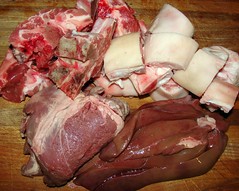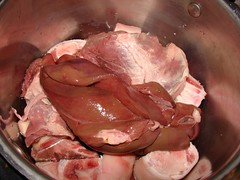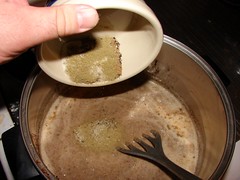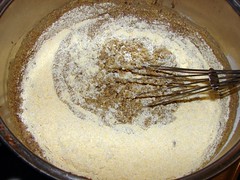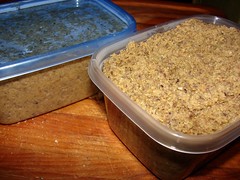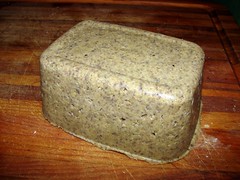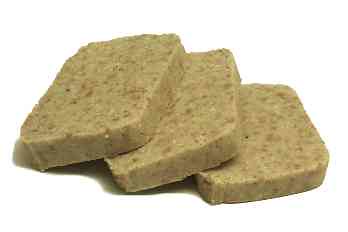
If you're not from the northeastern United States - especially Pennsylvania, Maryland, Delaware, or southern New Jersey - there's a chance you've never heard of scrapple.
Scrapple is a pork product. Basically, it's a spicy polenta with pork added. Finely minced or shredded cooked pork is mixed in a mush with cornmeal and spices and cooked until thick, then cooled in a mold, sliced, and fried. Originally, it was made with "scraps" of pork and pork offal unsuitable for other purposes at hog butchering time - hence the name - but most recipes today call for readily available cuts of pork rather than odd bits.
To cook scrapple, the loaf is cut into slices about a quarter of an inch thick and fried until brown on both sides. Some people flour the slices lightly before frying, but I don't bother. I usually melt a little butter or bacon fat in the pan and put in the slices after the fat melts, frying them over medium heat until they are brown and crispy outside and creamy smooth on the inside. Another excellent way of preparing scrapple is to slice them a little thinner and then brown thoroughly on both sides until each slice of scrapple is like a crunchy cracker. This intensifies the porky flavor and the spices and offers a completely different taste sensation. It can also be deep-fried (I ordered scrapple for breakfast at a diner in southern New Jersey once, and that's how they cooked it. It was a massive 3/4-inch-thick slab of deep-fried porkmushy goodness, and although it was more magically delicious than a bowl of Lucky Charms I'd never cook it that way at home.)
Scrapple is a great breakfast food, as an accompaniment to eggs and home fries, or all by itself. Its savory deliciousness puts it in the same league as bacon or sausage, and it lends itself to pairing not only with mild foods like eggs but also to sweeter partners, like maple syrup (
and figs!)
There are many commercially available scrapples on the market. I've tried several of them, but it's taken some effort to do; New England is on the outer periphery of scrapple territory and when I find it at all, it's generally Jones brand, in the freezer case next to the sausages. Here's a rundown of my impressions of the ones I've tried:
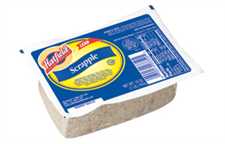 Hatfield Scrapple
Hatfield Scrapple - Wetter than most others, slices of Hatfield in the skillet popped and launched cornmealy shrapnel into the kitchen. Saltier than others with a faint rancid taste. I've given Hatfield two tries and neither of them were very good. A scrapple of "last resort." Pity, too, because Hatfield bacon is pretty decent.
RAPA, Habbersett, and
Jones Farm scrapple - These seem to be the Big Three of the scrapple industry, and they are all owned by Jones Farm. Despite what their websites and company spokesmen say about "distinctive old family recipes," there isn't a bit of difference in the taste of the standard scrapple products. I've had all three side by side in blind trials and they all tasted identical. And delicious, I might add. I grew up eating Jones Farm scrapple, and whenever I have some of the famous RAPA brand or the almost equally-famous Habbersett, it's like revisiting a favorite flavor.
RAPA Hot & Spicy Scrapple - It's made by RAPA so it tastes great, but unfortunately I have never detected a bit of "heat" in the stuff despite the jalapeño peppers listed in the ingredients. My wife, who doesn't like spicy food very much, reluctantly tried some and agreed that it was quite mild.
RAPA Scrapple with Bacon - Quite good, it reminds me strongly of the flavor I get when I cook plain scrapple in a bit of bacon fat. The smoky overtones of bacon just naturally go well with scrapple.
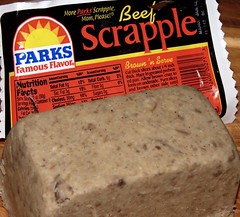 Parks Beef Scrapple
Parks Beef Scrapple - A very different product than the pork variety, Parks Beef Scrapple has a hearty beef flavor with notes of liver and, to a lesser extent, tripe (turns out that there is tripe in the mix.) The first thing I noticed about it was how the knife refused to glide through the way it does with the porky varieties - I actually had to cut through. More chunky and uneven in texture that the pork, I could see bits of gristle, tripe, and ominous dark-colored "meat" in there. It's good enough that I buy it when I can find it (which is not often, and not a surprise, since the supermarket where I occasionally find it
never carries Parks regular pork scrapple.)
Relevant links:RAPA Scrapple - If you really need a scrapple fix, RAPA ships their stuff all over the country from November to February (cold weather is their "shipping season.") You can find details at their page.
Habbersett Scrapple - Click on "NEWS" on their homepage and you'll find a list of recipes which call for scrapple as an ingredient.
Jones Dairy Farm - Click through the "Products" link on their main page to find scrapple; try not to get distracted by all the delicious sausage products you'll find on the way.
Hatfield Quality MeatsTOMORROW: Make your own scrapple! Recipes, tips, techniques, and more.


